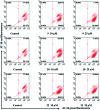Synthesis and anti-cancer activities of glycosides and glycoconjugates of diterpenoid isosteviol
- PMID: 31673312
- PMCID: PMC6786240
- DOI: 10.1039/c9md00242a
Synthesis and anti-cancer activities of glycosides and glycoconjugates of diterpenoid isosteviol
Abstract
A series of glycosides and glycoconjugates of diterpenoid isosteviol (16-oxo-ent-beyeran-19-oic acid) with various monosaccharide residues were synthesized and their cytotoxicity against some human cancer and normal cell lines was assayed. Most of the synthesized compounds demonstrated moderate to significant cytotoxicity against human cancer cell lines M-HeLa and MCF-7. Three lead compounds exhibited selective cytotoxic activities against M-HeLa (IC50 = 10.0-15.1 μM) that were three times better than the cytotoxicity of the anti-cancer drug Tamoxifen (IC50 = 28.0 μM). Moreover, the lead compounds were not cytotoxic with respect to the normal human cell line Chang liver (IC50 > 100 μM), whereas Tamoxifen inhibited the viability of normal human Chang liver cells with an IC50 value of 46.0 μM. It was determined that the cytotoxicity of the lead compounds was due to induction of apoptosis proceeding along the mitochondrial pathway. The cytotoxic activity of the synthesized compounds substantially depended on the nature of the monosaccharide residue and its position, that is, whether the monosaccharide residue was attached directly to the isosteviol skeleton or was moved away from it by means of a polymethylene linker.
This journal is © The Royal Society of Chemistry 2019.
Figures





Similar articles
-
Glycosides and Glycoconjugates of the Diterpenoid Isosteviol with a 1,2,3-Triazolyl Moiety: Synthesis and Cytotoxicity Evaluation.J Nat Prod. 2020 Aug 28;83(8):2367-2380. doi: 10.1021/acs.jnatprod.0c00134. Epub 2020 Jul 29. J Nat Prod. 2020. PMID: 32786882
-
Synthesis and cytotoxicity of the conjugates of diterpenoid isosteviol and N-acetyl-D-glucosamine.Nat Prod Res. 2021 Apr;35(8):1372-1378. doi: 10.1080/14786419.2019.1650355. Epub 2019 Aug 12. Nat Prod Res. 2021. PMID: 31402704
-
Synthesis, antimicrobial activity and cytotoxicity of triphenylphosphonium (TPP) conjugates of 1,2,3-triazolyl nucleoside analogues.Bioorg Chem. 2021 Nov;116:105328. doi: 10.1016/j.bioorg.2021.105328. Epub 2021 Sep 3. Bioorg Chem. 2021. PMID: 34500307
-
Triphenylphosphonium Cations of the Diterpenoid Isosteviol: Synthesis and Antimitotic Activity in a Sea Urchin Embryo Model.J Nat Prod. 2015 Jun 26;78(6):1300-8. doi: 10.1021/acs.jnatprod.5b00124. Epub 2015 Jun 4. J Nat Prod. 2015. PMID: 26042548
-
Diterpenoid lead stevioside and its hydrolysis products steviol and isosteviol: Biological activity and structural modification.Eur J Med Chem. 2018 Aug 5;156:885-906. doi: 10.1016/j.ejmech.2018.07.052. Epub 2018 Jul 24. Eur J Med Chem. 2018. PMID: 30059803 Review.
Cited by
-
Anticancer activity and evaluation of apoptotic genes expression of 2-azetidinones containing anthraquinone moiety.Mol Divers. 2021 Nov;25(4):2429-2439. doi: 10.1007/s11030-020-10142-x. Epub 2020 Sep 18. Mol Divers. 2021. PMID: 32944866
-
The Formation of Morphologically Stable Lipid Nanocarriers for Glioma Therapy.Int J Mol Sci. 2023 Feb 11;24(4):3632. doi: 10.3390/ijms24043632. Int J Mol Sci. 2023. PMID: 36835043 Free PMC article.
-
The Finally Rewarding Search for A Cytotoxic Isosteviol Derivative.Molecules. 2023 Jun 23;28(13):4951. doi: 10.3390/molecules28134951. Molecules. 2023. PMID: 37446613 Free PMC article.
References
LinkOut - more resources
Full Text Sources
Research Materials
Miscellaneous

